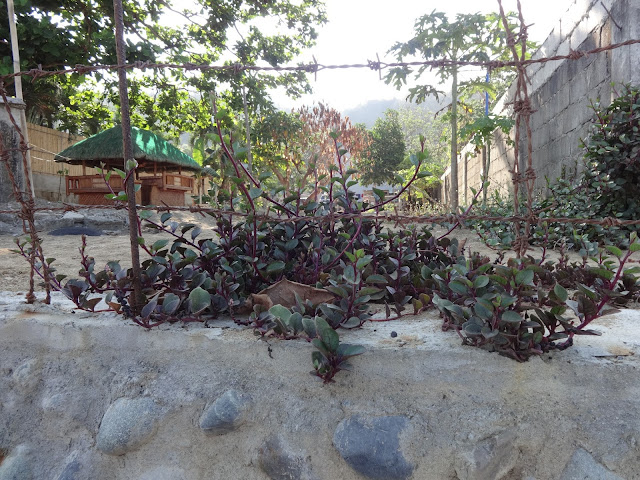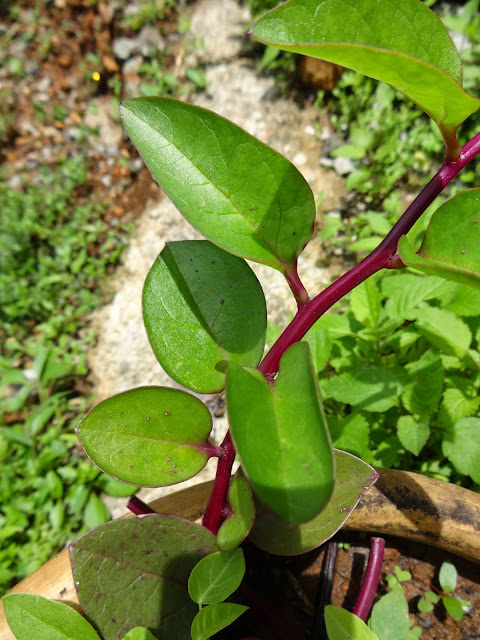 Polska wersja
Polska wersjaPLANT PROFILE
Garlic Vine is a highly ornamental, tropical climbing plant, native to Amazon rainforest, where it is commonly known as Ajos Sacha (or Ajo Sacho or Ajossacha), which means False Garlic in Spanish. The reason for that is its characteristic garlic-like smell of leaves when crushed. This smell is caused by the same chemicals that are found in Garlic, and so this vine share Garlics taste and medicinal values. Because of the beauty of its flowers it can be found in gardens of Southeast Asia (it is called Blue Shower in Pakistan) and other tropical regions, as well as like a house plant in temperate zones. But its medicinal properties are barely known outside its motherland, where it is playing significant role in traditional healing and modern herbalism. Ajos Sacha is also one of plants that is used in spiritual rituals of Amazonian tribes. It is often taken before Ayahuasca ritual - to cleanse the blood and body, bring both physical and mental well being, to ward off evil spirits and bring good luck. For this purpose it is often burned in houses.
Garlic Vine have many other common names that relates to Garlic - Garlic Creeper, Garlic Shrub, Garlic Rope, Amazonian Garlic Bush, Bejuco de Ajo, Ajos del Monte, Sucho Ajo and Cipo de Alho, to mention just some. Its most popular latin name is Mansoa alliacea but it has so many synonyms that are still in use that it can cause every botanist a headache. Here are some of it : Pseudocalymma alliaceum, Cydista aequinoctialis, Bignonia alliacea, Bignonia aequinoctialis, Adenocalymma alliaceum, Adenocalymma pachypus, Pachyptera alliacea, Pseudocalymma sagotti, Pseudocalymma pachypus.
 CULTIVATION AND HARVESTING
CULTIVATION AND HARVESTINGMansoa alliacea is evergreen, semi-woody vine that can climb even up to 12 m, but usually it is around 3 m tall. It often clings to tree trunk, fence or wall (usually needs support to attach) to climb, or form kind of a bush on its own. As a tropical plant it likes high temperatures and humidity. Temperatures below 0'C can easily kill this plant, which makes it suitable only as a houseplant in temperate regions. It can grow in half shade, but to produce abundance of flowers it require full sun. It might flower intensively 2 - 3 times a year, and its beautiful flowers lasts around 3 weeks, changing its colour from lavender-violet to bleak-violet into alost white. To support growth of new flower buds, clusters of old wilted flowers should be cut off, othervise plant will produce seed pods instead new flower buds. Garlic vine releases its garlicky smell only when crushed or pruned. It can be propagated thru seeds or cuttings, for both ways it require heat. Leaves can be picked at any time of year.
CULINARY USES
In Amazon Rainforest, local people are using leaves of Garlic Vine as a seasoning and spice. Fresh young and soft leaves and stems can be chopped and uses like chives to sprinkle on salads, sandwitches, mashed potatos or any other food. Old tough leaves can be used fresh crushed or chopped, or dried and crushed or powderized, it can be used for cooking as a Garlic substitute.
Flowers when young and dark violet, has nice crispy texture and unique freaky taste. It is sweet and fruity with garlic aftertaste. As it turns older its colour is getting bleak into light pink and its texture become more papery, it is still useful but less sweet and fruity.
MEDICINAL USES
 Ajos Sacha is commonly used in traditional medicine of Amazon tribes, for fevers, colds, flu, cough, asthma, pneumonia and other respiratory problems, rheumatic and arthritic pains and other inflammations, malaria, cancer, myalgia, mycosis, lumbago, headache, nervousness, nervous shock, neurosis, uterine disorder, epilepsy, cramps, wounds, swellings, high cholesterol, indigestion and constipation.
Ajos Sacha is commonly used in traditional medicine of Amazon tribes, for fevers, colds, flu, cough, asthma, pneumonia and other respiratory problems, rheumatic and arthritic pains and other inflammations, malaria, cancer, myalgia, mycosis, lumbago, headache, nervousness, nervous shock, neurosis, uterine disorder, epilepsy, cramps, wounds, swellings, high cholesterol, indigestion and constipation. Leaves can be eaten fresh or dried, and all parts of plant including roots can be taken in form of infusion, decoction (some of it properties might be lost due to long, high heat exposure), tincture, or capsules, but decoctions and tinctures are usually made from bark or root. Its properties are analgesic, anodyne, antioxidant, antifungal, antiarthritic, antirheumatic, antiinflammatory, antispasmodic, antitussive, antiviral, antibacterial, stomachic, febrifuge, astringent, tonic, depurative, laxative, vermifuge and insecticidal.
Mansoa alliacea contains alkaloids, tannins, phenols (i.a. lapachol derivatives), flavonoids (anthocyanins), glycosides, saponins, lignins, triterpenoids, quinones and sterols (beta sitosterol, stigmasterol, daucosterol, fucosterol) . It is most characteristic for containing the same sulphur compounds that are found in Garlic, like alliin and allyl sulphides. These chemical compounds are known to lower cholesterol level and inhibit absorbtion of cholesterol in the intestines. The wood of Garlic vine contain two lapachone chemicals, that have proved anticancer activity.
Decoctions of stems with leaves are applied externaly on rheumatic and arthritic pains, muscular fatigue, swellings and inflammations of skin. A tincture of the root in cane alcohol is taken as a overall regenerative whole body tonic. Tea made from leaves is taken by the Amuesha people of Peru to aid women fertility. Leaves are often added to baths by some tribes, to fight flu, fevers, body aches, cramps and fatige. It is also used as a insect and snakes repellent. Crushed leaves can be applied as a patch on forehead for headache.

Sources
'' Duke's Handbook of Medicinal Plants of Latin America '' - James E Duke, CRC Press 2008
'' The London Medical Record, Tom 6 '' - Ernest Abraham Hart, Elder Smith 1878
'' Wild Foresting : Practising Nature's Wisdom '' - Alan Drengson, Duncan Taylor, New Society Publishing 2008
'' Novel Technologies in Food Science : Their Impact of Products, Consumer Trends and the Environment '' - Anna McElhatton, Paulo Jose do Amaral Sobral, Springer Science & Business Media 2011
'' The Ayahuasca Diaries '' - Caspar Greef, Jacana Media 2010
http://www.rain-tree.com/ajos-sacha-traditional-uses.pdf
http://www.rain-tree.com/ajos-sacha-chemicals.pdf
http://www.rain-tree.com/ajos-sacha-activity.pdf
http://www.practicalgardening.blackdovenest.com/2013/10/garlic-vine-mansoa-alliacea-cydista.html
http://davesgarden.com/guides/pf/go/119636/#b
http://www.researchgate.net/publication/244484400_Phytochemical_studies_on_Mansoa_alliacea_(Lam.)
https://toptropicals.com/catalog/uid/Mansoa_alliacea.htm
http://www.yana-puma.com/en/what-is-ajos-sacha/#
http://www.sybout.com/vines_creepers.htm
http://www.plantsrescue.com/tag/garlic-vine/
http://www.somemagneticislandplants.com.au/index.php/plants/296-mansoa-alliacea
http://www.flowersofindia.net/catalog/slides/Garlic%20Vine.html
http://tropical.theferns.info/viewtropical.php?id=Mansoa+alliacea
http://www.scielo.br/scielo.php?pid=S0102-695X2009000500025&script=sci_arttext
http://www.ars-grin.gov/cgi-bin/duke/ethnobot.pl?ethnobot.taxon=Cydista%20aequinoctialis
http://www.gardeningpakistan.com/viewtopic.php?f=37&t=2927






















































